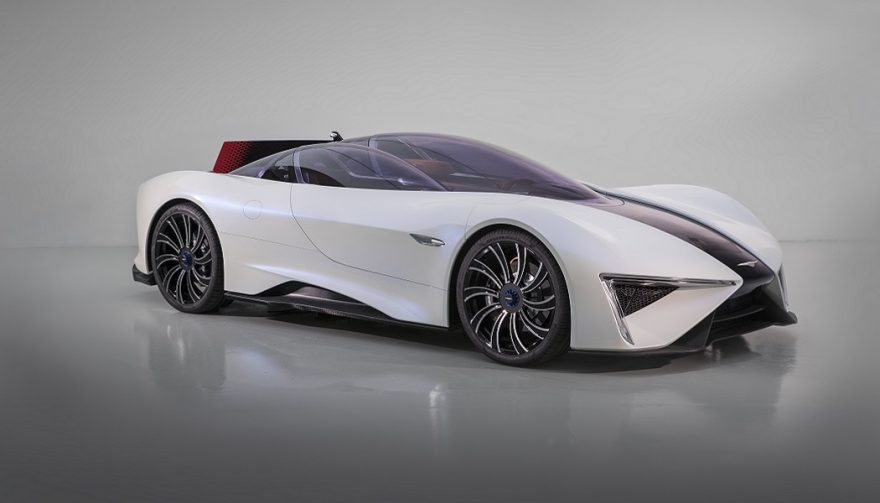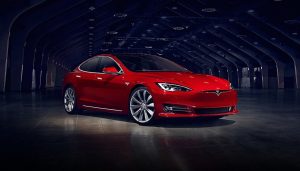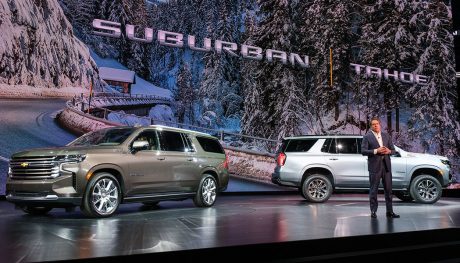
The Techrules supercar Ren uses a canopy-style door for its passengers
This Techrules Supercar Is Rewiring Electric Car Rules
The recently unveiled Techrules supercar is a 1,000-plus hp, three-seat turbine-electric hybrid vehicle. That’s right. Turbine-electric supcar.
The China-based research and development company just unveiled its first production design for this series of hybrid vehicles, called “Ren.”
Techrules’ out-of-the-box creation also recently completed testing at one of the world’s oldest and most storied race circuits, Monza. Maybe they mean business?
Performance Potential
Underneath the sculpted, intriguing exterior lies the bits that make this car different from all the other supercars.
The hybrid system operates six separate electric motors to control the go, two for the front wheels and four for the rear. And while that may not seem overly special, the turbine engine used to re-generate electricity is.
Techrules calls its turbine tech TREV, for Turbine-Recharging Electric Vehicle. The name is not only simple and explanatory, it also calls attention to a new spin on an old concept.
Turbines aren’t new concepts in the automotive market. The Chrysler Turbine Car of the early 1960s is the most famous, or infamous, example. It used a gas-turbine engine in place of the standard internal combustion engine.
Of the 55 built, only nine remain, relegated to lives in museums, collections and Jeopardy! questions.
Just because the turbine hasn’t worked in the past doesn’t mean it can’t do so in the future. The main differences here are 50 years of technological development and the use of an electric drive rather than mechanical.
Not only that, Techrules recruited some quality European help to bring their dream to reality.
One in the Front, Two in the Back
Lauded Italian designers Giorgetto and Fabrizio Guigiaro are working on the aesthetics.
Seating in this Techrules supercar follows the McLaren F1 model, with the driver in the center of the cockpit flanked by two seats slightly set back. An LMP1/F1-esque shark fin rises from the rear spine for aerodynamic purposes.
Another highlight is the cockpit-like canopy that serves as this supercar’s sole door. It may not be the most practical entry system, but it’s a natural evolution for the jet fighter-inspired interiors featured on most supercars and hypercars these days.
More Than Just Vaporware?
While Techrules’ creation is an interesting next step in the advancement of vehicle speed and performance, there is still the elephant in the room to address.
Can a company with no previous supercar or automotive experience, whose only web presence is a basic press release website, become anything more than another quiz show question?
The automotive landscape is littered with examples of innovative companies that went the way of the dodo, from Tucker to DeLorean to Fisker. Established automakers aren’t immune from shutting operations, as Pontiac, Mercury and Oldsmobile can attest to.
That’s not to say starting a supercar manufacturer from scratch hasn’t been done. Pagani was just a curious oddity a decade ago with the Zonda. It is now pretty well established within the hypercar realm. Lamborghini’s were born from a tractor maker’s desires.
To their credit, the Techrules bosses seem to realize their limitations on the project and hired some top notch design and development teams for support. The company is also looking at small production batches, sending only two dozen or so every year to well-heeled customers.
Still a Lot to Be Seen
Honestly, it remains to be seen how far Techrules can take their invention. The supercar world is competitive, cutthroat and ruthlessly meritocratic. You either perform, and perform well, or die.
Whether or not Ren can perform is the great unknown. Other than the aforementioned test at Monza, there hasn’t been much information about this car since its original debut in Geneva last year. And even the Monza test sessions didn’t reveal much about the car’s performance potential.
Despite these issues, what we have here is an innovative supercar that is looking outside of the established routes, exploring and expanding what is possible with the automobile. Sometimes it takes someone out of left field to change the game.
Not only that, it’s hard to complain when you get to look at automotive artwork from Giorgetto and his son.





